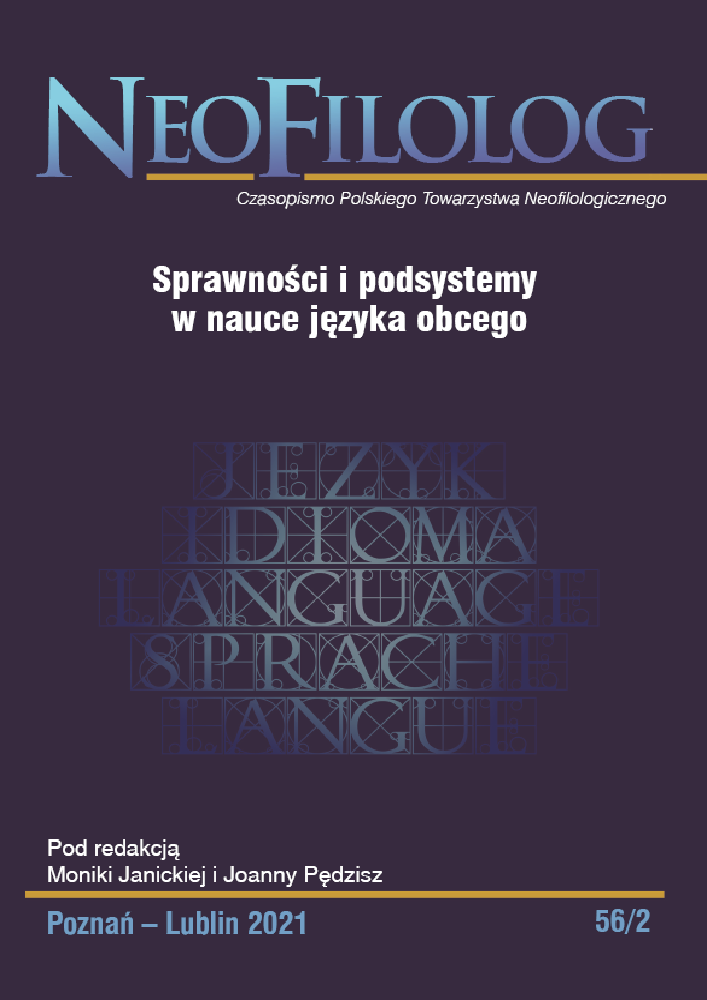Abstract
The paper emphasizes the role of linguistic intuition in current L2 processing. Intuition, as a mental disposition operating in implicit systems, is in close correlation with working memory. It infers quick, almost immediate meaning of un unknown word which appears in a context. Linguistic intuition has a regulatory function, i.e. it allows to continue language activities and overcome linguistic deficits. In the second part, Timed inference test as a tool for developing and testing vocabulary is proposed as well as the results of the empirical study on intuitive behaviour in L2. The results of the study show that inference of word’s meaning under time constraint is lower that the results of inference without time pressure. The study involves a group of 102 students of French as a foreign language at B1 level.
Literaturhinweise
Baddeley A. (1998), Pamięć. Poradnik użytkownika. Warszawa: Prószyński i S-ka.
Baddeley A. (2007), Working memory, thought and action. Oxford: Oxford University Press.
Baddeley A. (2012), Working memory: Theories, Models, and Controversis. „Annual Review of Psychology”, nr 63, s. 1–29.
Cichoń M. (2011). Zdolny uczeń - autonomiczny uczeń: jak rozwijać skutecznie strategie uczenia się na lekcji języka obcego. „Neofilolog”, nr 36, s. 319–329.
Chomsky N. (1965). Aspects of the Theory of Syntax. Cambridge Massachu-setts: MIT Press.
Dakowska M. (2007), Psycholingwistyczne podstawy dydaktyki języków ob-cych. Warszawa: Wydawnictwo Naukowe PWN.
Desclés, J.-P. (1993). Relations casuelles et schèmes sémantico-cognitifs. „Langages”, 113, s. 113 – 125.
Dźwirzyńska E. (2016), Psychologiczne czynniki warunkujące możliwość intensyfikacji przyswajania obcojęzycznej leksyki w procesie kształtowania kompetencji komunikacyjnej. „Linguodidactica”, Tom XX, s. 51–61.
Gao, H. (2012), A quantitative study into Chinese EFL learners’ lexical infer-ence ability and strategy use in EFL reading. „Linguistic Culture Education”, 1, s. 58–77.
Gigerenzer G. (2007), Le génie de l’intuition. Intelligence et pouvoirs de l’inconscient. Przeł. M. Garène, Paris: Belfond.
Jung C.G. (1921/2015), Typy psychologiczne. Przeł. R. Reszke, Warszawa: Wydawnictwo KR.
Komorowska H. (2002), Metodyka nauczania języków obcych. Warszawa: Fraszka Edukacyjna.
Kwapisz-Osadnik K. (2010), Językoznawstwo kognitywne w nauczaniu języ-ków obcych: projekt gramatyki wizualnej na przykładzie francuskiego trybu subjonctif. „Neofilolog”, nr 34, s. 133–147.
Laskowski M. (2009), Związki frazeologiczne jako problem dydaktyczny na lekcjach języków obcych. „Języki obce w szkole”, 2, s. 16–28.
Lewandowska-Tomaszczyk B.(2006), Metody empiryczne i korpusowe w językoznawstwie kognitywnym, (w:) Stelmaszczyk P. (red.), Metodologia językoznawstwa. Podstawy teoretyczne. Łódź: Wydawnictwo Uniwersytetu Łódzkiego, s. 251–281.
Nation I. S. P. (2001), Learning vocabulary in another language, Cambridge: Cambridge University Press.
Nosal C. S. (2010), Umysł poczwórnie ograniczony. Bariery i kompensacje w poznaniu. „Studia z kognitywistyki i filozofii umysłu”, nr 4, s. 5–25
Nosal C. S. (2011), Interakcja inteligencji i intuicji: nowa teoria funkcjonowa-nia umysłu. „Czasopismo Psychologiczne”, Tom 17 nr 2, s. 207–218.
Pawlak M. (2010), Problemy pomiaru wiedzy językowej. „Neofilolog”, nr 35, s. 9–22.
Piegzik W. (2020), Intuicja językowa i jej funkcja oceniająca: na przykładzie języka francuskiego jako obcego. „Prace Językoznawcze”, XXII/1, s. 219–238.
Piegzik W. A. (w druku), Od intuicji językowej do zachowań intuicyjnych w języku: na przykładzie języka francuskiego jako obcego. Warszawa: Wydawnictwo Naukowe PWN.
Redouane, R. (2004), Assessing institutional method in L2 French vocabulary ac-quisition: Guessing-from-context method versus a word-list method. On line: http://homepage.mac.com/Tefftennant/welfa/WELFA [DW: 2.02.2021]
Roch E. (1978), Principles of categorization, (w:) Roch E. (red.) Cognition and Categorization. B.B. Lloyd, New Jersay: Hillsdale, s. 27–48.
Sułkowska M. (2018), Phraséologie appliquée et ses nouvelles branches : phraséodidactique et phraséotraduction. „Romanica Cracoviensia”, 3, s. 159–170.
Lizenz
Copyright (c) 2021 Wioletta A. Piegzik

Dieses Werk steht unter der Lizenz Creative Commons Namensnennung - Keine Bearbeitungen 4.0 International.
Autoren:
Die Autoren der zur Veröffentlichung in der Zeitschrift Neofilolog angenommenen Texte sind verpflichtet, den Vertrag über die Erteilung einer kostenlosen Lizenz für die Werke mit der Verpflichtung zur Erteilung einer Sublizenz CC auszufüllen, zu unterzeichnen und an die Adresse der Redaktion zurückzusenden.
Gemäß Vertrag erteilen die Autoren auf die in der Zeitschrift Neofilolog veröffentlichten Texte der Adam-Mickiewicz-Universität in Poznań eine nicht exklusive und kostenlose Lizenz und erlauben die Verwendung der Sublizenz Creative Commons Attribution-NoDerivatives 4.0 International (CC BY-ND 4.0).
Die Autoren behalten das Recht zur weiteren freien Verfügung über das Werk.
Benutzer:
Interessierte Onlinebenutzer dürfen die seit 2017 veröffentlichten Werke unter folgenden Bedingungen nutzen:
- Anerkennung der Urheberschaft - die Verpflichtung, zusammen mit dem verbreiteten Werk Informationen über die Urheberschaft, den Titel, die Quelle (Links zum Originalwerk, DOI) und die Lizenz selbst bereitzustellen;
- ohne Schaffung abgeleiteter Werke - das Werk muss in seiner ursprünglichen Form erhalten bleiben, ohne Zustimmung des Autors dürfen keine Studien, beispielsweise Übersetzungen, verbreitet werden.
Die Urheberrechte aller veröffentlichen Texte sind vorbehalten.
Sonstige:
Die Adam-Mickiewicz-Universität in Poznań behält das Recht auf die Zeitschrift als Gesamtheit (Layout, Grafik, Titel, Umschlagsprojekt, Logo usw.).

